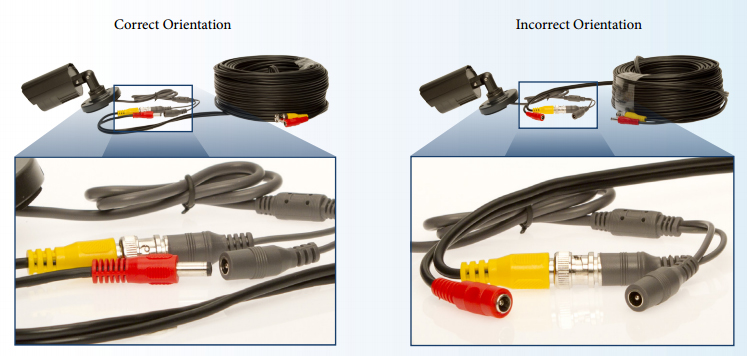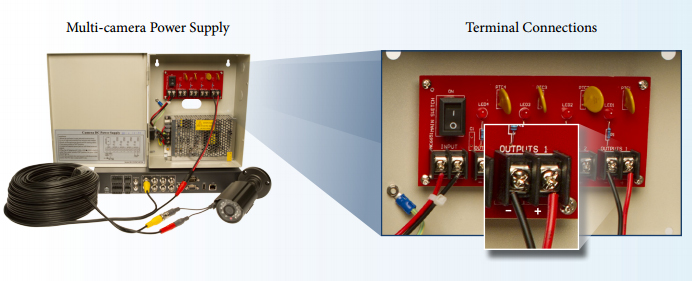INSTALL CCTV SECURITY CAMERAS - QUICK START GUIDE
Do you plan to install analog CCTV surveillance systems? This is the quick start guide that intends to teach you how to physically install the security camera system. Before installing the security camera system, please make sure that you got everything needed to setup a surveillance system. A complete surveillance system includes digital video recorder (DVR), security cameras, power supply, 3+1 coaxial cables (power/video cables, monitor/display and optional equipment (e.g., battery backup,)
STEP 1: CABLE INSTALLATION
It's highly recommended to perform a thorough site survey to determine cable pathways and camera mounting locations before installing each multi-purpose power/video cable. The most frequently encountered problem when installing pre-made, Universal Plug-n-Play (UPnP) power/video cable is incorrectly orienting the cable. This is particularly troublesome when, say, the cable(s) is/are installed prior to sealing a wall.
Tech Tip: Use a permanent marker or labeler to mark the end of the cable that correctly matches the camera BEFORE installing the cable. Most entry-level security cameras include a molded female DC power jack designed for tool-less connection to the cable’s male DC power plug. A correctly oriented cable requires no additional mating adapters, splices, or similar cable modifications. This completes the cable installation step

STEP 2: CAMERA CONNECTIONS
With cable installation out of the way, it is now time to begin mounting and connecting the security cameras. Camera mounting instructions differ from camera to camera with most installations falling into the following categories:
• Bullet Cameras - Most bullet-style camera manufacturers include 3 to 4 self-tapping screws for securing the camera’s included mounting bracket to most flat vertical or horizontal surfaces. Screw anchors may also be included for mounting the camera to sheet rock, concrete block, brick, wood.
• Dome Cameras – Dome cameras are primarily designed for horizontal mounting, however, an increasing number of manufacturers provide highly maneuverable 3-axis (pan, tilt, & twist) gimbals & elongated dome bubbles for increased mounting flexibility. Elongated dome bubbles (“egg domes”) are especially useful when vertically mounting night vision dome cameras because they increase the camera’s overall Field of View (FoV) while simultaneously reducing undesirable Infrared (IR) reflections & glare. (Please consult the supplied camera manual for detailed installation instructions.)
With the cameras installed and in place, begin connecting camera-to-cable by first mating the camera’s female BNC (Bayonet Neill-Concelman) connector to the cables male BNC connector. Next, mate the camera’s female DC power jack to the corresponding male DC power plug.
Tech Tip: Video/power connections are NOT weatherproof. Enclosing them in a weatherproof, single-gang electrical junction box, or j-box, can protect exposed connections. J–boxes are inexpensive and can be found in the electrical aisle of most hardware or home improvement stores. This completes the camera installation & connection step.
# STEP 3: POWER CONNECTIONS
Security Camera Systems ship with one of two types of power supply units -- plug-in (wall tap) transformers or, centralized (multi-camera) power supplies. Wall tap transformers are very similar to those used to power common household electronic devices, such as cordless telephone receivers. Wall tap transformers are supplied with all (4)-camera security systems. Multi-camera power supplies employ a single transformer to distribute power via a predefined number of outlets. Multi-camera power supplies provide the following system benefits:
- Power Management – true multi-camera power distribution.
- Cable Management – safely & efficiently manage multiple cables.
- Surge Protection – Individual fuse-or circuit breaker-protected outputs.
Multi-camera – Power/video cable is not designed to interface directly with the multi-camera power supply. A male DC power adapter “pigtail” is required to connect the cable’s female DC power jack to the appropriate power supply output terminals.

Tech Tip: Obey proper DC voltage wiring conventions by adhering to the following color-coded wire designations: Red = Positive (+), Black = Negative (-). AC power supplies use alternating current, so polarity does not have to be observed.



